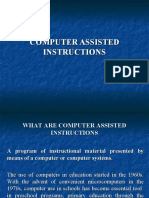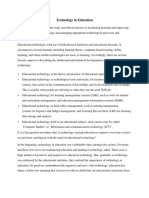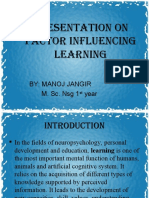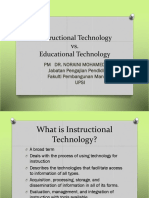E Learning
Uploaded by
Shivinder SinghE Learning
Uploaded by
Shivinder Singh1
INTRODUCTION
E-learning is a new education concept by using the Internet technology, it deliveries the digital content, provides a learner-orient environment for the teachers and students. The e-learning promotes the construction of life-long learning opinions and learning society. It means: 1. E-learning is a new education concept; it may different from the old educational concept. We should provide a new explanation to this new concept. 2. Delivery of the digital content is the main characters of e-learning. We can tell what is elearning and what is not. 3. This definition extends the environment on the Internet. We mean that the Internet provides a learning environment for the students and teachers. This environment is learner-oriented, so we can throw out the thoughts of traditionally teacher-center's instruction in classroom. 4. As a new concept of education, e-learning gives a condition for us to realize the life-long learning principle and help us to build a more real learning society. E-learning includes all forms of electronically supported learning and teaching, and more recently Edtech. The information and communication, whether networked learning or not, serve as specific media to implement the learning process. The term will still most likely be utilized to reference out-of-classroom and in-classroom educational experiences via technology, even as advances continue in regard to devices and curriculum. Abbreviations like
CBT (Computer-Based Training), IBT (Internet-Based Training) or WBT (Web-Based Training) have been used as synonyms to e-learning. E-learning is the computer and network-enabled transfer of skills and knowledge. E-learning applications and processes include Web-based learning, computer-based learning, virtual education opportunities and digital collaboration. Content is delivered via the Internet, intranet/extranet, audio or video tape, satellite TV, and CD-ROM. It can be self-paced or instructor-led and includes media in the form of text, image, animation, streaming video and audio. It is commonly thought that new technologies can strongly help in education. In young ages especially, children can use the huge interactivity of new media, and develop their skills, knowledge, perception of the world, under their parents monitoring, of course. Many proponents of e-learning believe that everyone must be equipped with basic knowledge in technology, as well as use it as a medium to reach a particular goal.
HISTORY OF E-LEARNING
In the early 1960s, Stanford University psychology professors Patrick Suppes and Richard C. Atkinson experimented with using computers to teach math and reading to young children in elementary schools in East Palo Alto, California. Stanford's Education Program for Gifted Youth is descended from those early experiments. In 1963, Bernard Luskin installed the first computer in a community college for instruction, working with Stanford and others, developed computer assisted instruction. Luskin completed his landmark UCLA dissertation working with the Rand Corporation in analyzing obstacles to computer assisted instruction in 1970. Early e-learning systems, based on Computer-Based Learning/Training often attempted to replicate autocratic teaching styles whereby the role of the e-learning system was assumed to be for transferring knowledge, as opposed to systems developed later based on Computer (CSCL), which encouraged the shared development of knowledge. As early as 1993, William D. Graziadei described an online computer-delivered lecture, tutorial and assessment project using electronic mail. By 1994, the first online high school had been founded. In 1997 Graziadei, W.D., et al. published an article entitled "Building Asynchronous and Synchronous Teaching-Learning Environments: Exploring a Course/Classroom Management System Solution". They described a process at the State University of New York (SUNY) of evaluating products and developing an overall strategy for technology-based course development and management in teaching-learning. The product(s) had to be easy to use and maintain, portable, replicable, scalable, and immediately affordable, and they had to have a high probability of success with long-term cost-effectiveness. Today many technologies can be, and are, used in e-learning, from blogs to collaborative software, ePortfolios, and virtual classrooms. Most eLearning situations use combinations of these techniques. Computer Based Learning
Computer-Based Learning made up many early E-Learning courses such as those developed by Murray Turnoff and Starr Roxanne Hiltzin the 1970s and 80s at the New Jersey Institute of Technology and the ones developed at the University of Guelph in Canada. Web-Based Training and Online Distance Learning The British Open University and the online distance courses at the University of British Columbia (where Web CT, now incorporated into Blackboard Inc. was first developed) began a revolution of using the Internet to deliver learning, making heavy use of online discussion between students in all their programs. Also, from the start, practitioners such as Harasim (1995) have put heavy emphasis on the use of learning networks for knowledge construction. Classroom 2.0 The term Classroom 2.0 refers to a method of using a type of Multi-User Virtual Learning Environment set-up to connect schools across geographical frontiers (known as 'eTwinning') to enhance educational outcomes and cultural integration. Schools based on the Classroom 2.0 concept make use of CSCL and the Internet to allow learners in one school to communicate with learners in another that they would not get to know otherwise. E-Learning systems based on Classroom 2.0 are culturally aware and take account of the different preferences of learners. Classroom 2.0 has been used effectively in Wales, England, Spain and Italy. E-Learning 2.0 The term E-Learning 2.0 is a neologism for CSCL systems that came about during the emergence of Web 2.0 From an E-Learning 2.0 perspective; conventional e-learning systems were based on instructional packets, which were delivered to students using assignments. Assignments were evaluated by the teacher. In contrast, the new e-learning places increased emphasis on learning and use of social software such as blogs, wikis, podcasts and virtual worlds such as Second Life. This phenomenon has also been referred to as Long Tail Learning See also (Seely Brown & Adler 2008) E-Learning 2.0, by contrast to e-learning systems not based on CSCL, assumes that knowledge (as meaning and understanding) is socially. Learning takes place through conversations about
content and grounded interaction about problems and actions. Advocates of social learning claim that one of the best ways to learn something is to teach it to others. In addition to virtual classroom environments, social networks have become an important part of E-learning 2.0. Social networks have been used to foster online learning communities around subjects as diverse as test preparation and language education. Mobile Assisted Language Learning (MALL) is a term used to describe using handheld computers or cell phones to assist in language learning. Some feel, however, that schools have not caught up with the social networking trends. Few traditional educators promote social networking unless they are communicating with their own colleagues.
TYPES OF E-LEARNING
E-learning can be delivered and presented to a learner in many different ways and for a range of purposes. The different types of E-learning are based on the degree of interactivity required of each. Tier-1 learning: Tier-1 learning involves low interactivity mainly text, multimedia or one-way communication. This type of learning can be delivered through PowerPoint presentation, learning on a personal digital assistant, e-books, podcasting, videotape and audiotape.
Tier-2 learning: Tier-2 learning involves moderate to high interactivity and has some degree of learner to computer interaction. This kind of e-learning can be delivered through interactive resources, quizzes, tests, reflective learning, games, demonstrations and simulations.
Tier-3 learning: Tier-3 learning involves higher interactivity and also includes learner to learner and learner to trainer interaction. It can be delivered through virtual classrooms, streaming media, group games, video conferences, audio conferences, chat groups, emails, discussion lists, blogging, wikis, and mob logging.
APPROACHES TO E-LEARNING SERVICES
E-learning services have evolved since computers were first used in education. There is a trend to move towards blended learning services, where computer-based activities are integrated with practical or classroom-based situations. Bates and Poole (2003) and the OECD (2005) suggest that different types or forms of e-learning can be considered as a continuum, from no e-learning, i.e. no use of computers and/or the Internet for teaching and learning, through classroom aids, such as making classroom lecture Powerpoint slides available to students through a course web site or learning management system, to laptop programs, where students are required to bring laptops to class and use them as part of a face-to-face class, to hybrid learning, where classroom time is reduced but not eliminated, with more time devoted to online learning, through to fully online learning, which is a form of distance education. This classification is somewhat similar to that of the Sloan Commission reports on the status of e-learning,[citation needed] which refer to web enhanced, web supplemented and web dependent to reflect increasing intensity of technology use. In the Bates and Poole continuum, 'blended learning' can cover classroom aids, laptops and hybrid learning, while 'distributed learning' can incorporate either hybrid or fully online learning. It can be seen then that e-learning can describe a wide range of applications, and it is often by no means clear even in peer reviewed research publications which form of e-learning is being discussed. However, Bates and Poole argue that when instructors say they are using e-learning, this most often refers to the use of technology as classroom aids, although over time, there has been a gradual increase in fully online learning (see Market above). Two popular tools for E-learning are Blackboard Inc. and Moodle: Blackboard Inc. has over 20 million users daily. Offering six different platforms: Blackboard Learn, Blackboard Collaborate, Blackboard Mobile, Blackboard Connect, Blackboard Transact, and Blackboard Analytics; Blackboard's tools allow educators to decide whether their program will be blended or fully online, asynchronous or synchronous. Blackboard can be used for K-12 education, Higher Education, Business, and Government collaboration. Moodle is an Open Source Course Management System. It is free to download and provides blended learning opportunities as well as platforms for distance learning courses. The Moodle website has many tutorials for creating a program or becoming a Moodle student.
Computer-based learning Computer-based learning, sometimes abbreviated to CBL, refers to the use of computers as a key component of the educational environment. While this can refer to the use of computers in a classroom, the term more broadly refers to a structured environment in which computers are used for teaching purposes. Cassandra B. Whyte researched about the ever increasing role that computers would play in higher education. This evolution, to include computer-supported collaborative learning, in addition to data management, has been realized. The type of computers has changed over the years from cumbersome, slow devices taking up much space in the classroom, home, and office to laptops and handheld devices that are more portable in form and size and this minimalization of technology devices will continue. Computer-based training Computer-based trainings (CBTs) are self-paced learning activities accessible via a computer or handheld device. CBTs typically present content in a linear fashion, much like reading an online book or manual. For this reason they are often used to teach static processes, such as using software or completing mathematical equations. The term Computer-Based Training is often used interchangeably with Web-based training (WBT) with the primary difference being the delivery method. Where CBTs are typically delivered via CD-ROM, WBTs are delivered via the Internet using a web browser. Assessing learning in a CBT usually comes in form of multiple choice questions, or other assessments that can be easily scored by a computer such as dragand-drop, radio button, simulation or other interactive means. Assessments are easily scored and recorded via online software, providing immediate end-user feedback and completion status. Users are often able to print completion records in the form of certificates. CBTs provide learning stimulus beyond traditional learning methodology from textbook, manual, or classroom-based instruction. For example, CBTs offer user-friendly solutions for satisfying continuing education requirements. Instead of limiting students to attending courses or reading printed manuals, students are able to acquire knowledge and skills through methods that are much more conducive to individual learning preferences.[citation needed] For example, CBTs offer visual learning benefits through animation or video, not typically offered by any other means.[citation needed] CBTs can be a good alternative to printed learning materials since rich media, including videos or animations, can easily be embedded to enhance the learning. Another advantage to CBTs is that they can be easily distributed to a wide audience at a relatively low cost once the initial development is completed.[citation needed]
However, CBTs pose some learning challenges as well. Typically the creation of effective CBTs requires enormous resources. The software for developing CBTs (such as Flash or Adobe Director) is often more complex than a subject matter expert or teacher is able to use. In addition, the lack of human interaction can limit both the type of content that can be presented as well as the type of assessment that can be performed. Many learning organizations are beginning to use smaller CBT/WBT activities as part of a broader online learning program which may include online discussion or other interactive elements. Computer-supported collaborative learning (CSCL) Computer-supported collaborative learning (CSCL) is one of the most promising innovations to improve teaching and learning with the help of modern information and communication technology. Most recent developments in CSCL have been called E-Learning 2.0, but the concept of collaborative or group learning whereby instructional methods are designed to encourage or require students to work together on learning tasks has existed much longer. It is widely agreed to distinguish collaborative learning from the traditional 'direct transfer' model in which the instructor is assumed to be the distributor of knowledge and skills, which is often given the neologism E-Learning 1.0, even though this direct transfer method most accurately reflects Computer-Based Learning systems (CBL). Blogs, wikis, and Google Docs are commonly used CSCL mediums within the teaching community. The ability to share information in an environment that is becoming easier for the lay person, has caused a major increase of use in the average classroom. One of the main reasons for its usage states that it is "a breeding ground for creative and engaging educational endeavors." Using Web 2.0 social tools in the classroom allows for students and teachers to work collaboratively, discuss ideas, and promote information. According to Sendall (2008), blogs, wikis, and social networking skills are found to be significantly useful in the classroom. After initial instruction on using the tools, students also reported an increase in knowledge and comfort level for using Web 2.0 tools. The collaborative tools additionally prepare students with technology skills necessary in today's workforce. Locus of Control remains an important consideration in successful engagement of E-learners. According to the work of Cassandra B. Whyte, the continuing attention to aspects of motivation and success in regard to E-learning should be kept in context and concert with other educational efforts. Information about motivational tendencies can help educators, psychologists, and technologists develop insights to help students perform better academically.
10
Technology-enhanced learning (TEL) Technology enhanced learning (TEL) has the goal to provide socio-technical innovations (also improving efficiency and cost effectiveness) for e-learning practices, regarding individuals and organizations, independent of time, place and pace. The field of TEL therefore applies to the support of any learning activity through technology
11
ADVANTAGES OF E-LEARNING
Flexibility, Accessibility, Convenience Learners can proceed through a training program "at their own pace and at their own place." They can also access the e-Learning course at any time and only as much as they need. This is also known as "Just in time and just enough." Browsers and Internet Connections are Widely Available Most computer users have access to a browser, such as Netscape or Internet Explorer, and are connected to a company's intranet and/or have access to the Internet. Inexpensive Worldwide Distribution No separate distribution mechanism is needed. E-Learning courses are accessible from any computer anywhere in the world, which keeps delivery costs low. Ease of Updates After the e-Learning course is released, any changes can be made on the server hosting the program and everyone worldwide can instantly access the update. Courses can be designed to access designated current information, such as the latest new product specifications, from any other server worldwide for an on-the-fly update whenever the e-Learning course is run. Savings in Travel Cost and Time There are no travel costs for bringing remote employees to a centralized workshop because the Web is available from all desktops. According to some analysts, the actual time required for training by computer averages about 50% to that of instructor-led training, further saving money. Better Retention: With clever design, user experience, and multimedia, online instruction can prove to be a richer and more effective learning experience than traditional methods and channels.
12
Lower Costs It is not uncommon for tuition at online schools to be lower than that of a traditional school, although this is certainly not true of all online programs. In addition, costs associated with things like commuting or typical classroom supplies are not relevant in an online learning environment, therefore, lowering overall costs. Furthermore, students might not have to worry about rising textbook prices as some programs may not require them or provide reading materials online. Commonly, students are able to download all materials needed for their classes, including lectures, assignments, additional notes, and other materials. No Sitting in a Classroom Since all classes are online, students will not have to attend classes. Lectures and other materials are electronically sent to the student who will then read them, prepare to take quizzes, and complete assignments. Students will never have to visit a classroom. Choosing Study Times Students will be able to plan their study time around the rest of their day instead of the other way around. It is the student's choice whether or not studying at nighttime or in the morning is best for them. It is recommended that students try to develop a study routine if they can. Having to work and attend classes at the same time can be very stressful. Online classes remove the stress by allowing students to learn when it is convenient for them. Balance a Job and Class Even though someone desires to go back to school, it doesn't mean that they want to leave their current job. Online degree programs make it so that they don't have to. Students will be able to go to work during the day and study at nighttime. Avoid Adverse Weather Conditions During snowstorms and thunderstorms, colleges may cancel classes. When colleges cancel classes, those classes sometimes have to be made up. This may cause the semester to run longer or the class may run longer in some cases.
13
DISADVANTAGES OF E-LEARNING
Technology dependent learners will need access to a machine of minimum specification as dictated by the elearning supplier or access to a service with a high bandwidth to transfer the course materials in a timely way. Material Incompatibility some materials designed for one particular system will not function properly on another (for example, the Apple Macintosh and the Windows PC). Standards will help in the area. Unsuitable for Certain Types of Training any skill that relies heavily on inter-personal contact although these courses could be supplemented by elearning. Unsuitable for Certain Types of Learners elearning requires a high-level of self-discipline and personal time management. eLearners need to be highly self-motivated to take full advantage of the medium as often the online learning experience can be impersonal. Working through 'packaged' programmes can be irritating. Reliant of the Quality of the Content it is too easy for some institutions to defer the photocopying costs onto the learner by placing all lecture notes and course handouts online. Such practices often mean that the course materials are in an inappropriate format for online learning. Course providers need to develop new technical skills and course design skills to suit the new medium.
14
Expensive start-up cost of an elearning service is expensive and the cost of production of online training materials is very high. Teachers must be confident that the extra costs are balance with the benefits of delivering a course online. Significant time needs to be invested in course set-up and in ongoing maintenance (checking links, updating course content etc.). Reliant on Human Support elearning is still dependent on help on either the course materials or the software. Social/economic disadvantage: can limit or prevent access by some student groups (for example, cost of equipment, online access and printing). No Match for Face-to-Face Teaching Electronic communication does not necessarily provide a good match for face-to-face communication and is more linear than face-to-face discussion. Too Reliant on IT Skills learners may have limited IT skills, or be uncomfortable with electronic communication and need to learn how to use the medium effectively. Disabilities Students with visual or physical impairments may be disadvantaged. Inflexible Flexibility may be lost as adjustments to the course in response to student reaction are not easy to make once the course is underway.
15
E-LEARNING IN INDIA
May, 2011 seems to be the beginning of a new era for Indian e-learning. With several companies and organizations announcing e-learning initiatives India is poised to address the gaps that have long existed in this part of the world.The e-learning era appears to have finally dawned in India. From being a largely outward looking industry, where Indian companies primarily served as a service provider for clients in US andEurope, Indian companies are becoming inward looking a clear reversal of trend. Leading this transformation are several Indian companies that have lined up with some very innovative offerings.
This month Educomp announced that it has joined hands with Great Lakes Institute of Management to provide e-learning education. The two partners are poised to invest around Rs 150 crores (15 million USD) in the next five years and the duo are planning to roll out e-learning management courses which will cost about 10 percent of the cost that a student spends in the regular courses. Sify meanwhile is planning to introduce a learning management system in India and they already have a couple of customers who are interested in its products.
At a corporate level Harvard Business Publishings (HBP) is planning to begin e-learning for Indian managers this year. The courseware will be delivered through the mobile platform. Close on its heal are other institutes like the Wharton's Executive Education Division that have also shown a keen interest in beginning such initiatives for the Indian manager.
Even iProf, which claims to be Indias first and largest e-learning superstore for IIT, CAT, PMT and other high-stakes tests on tablet computers, has announced an investment by Kaplan Ventures to enable the iProf platform to offer test preparation in GMAT and GRE, two exams required for admissions to most competitive U.S. business or graduate schools.
The Indian NGO sector too is not far behind and many have already begun using e-learning for furthering the cause of education for the marginalized and the disadvantaged sections of the society. Smile foundation of Ahmedabad has begun a innovative program called the Twin elearning Programme (STeP) which is designed to offer job-oriented skills to youth from the less
16
privileged sections of society living in urban slums and peripheral rural areas.
In Kolkata, a Jesuit-run media center is promoting e-learning in schools using audio-visual material in a bid to make lessons more interesting.
With so many different e-earning initiatives in the country, the service-driven mindset is rapidly getting replaced with an innovation-driven mindset. This however, brings forth a new challenge of gathering next level e-learning professionals who possess strong grounding in innovation. What it also requires is the need for the industry to enrich itself by drawing in the academic fraternity which has for long been kept out of the commercially-driven service industry. At the government level, IGNOU, Indias largest Open University, has announced the detailsof the virtual university for Africa after the Indian Prime Minister Manmohan Singh promised such an institution in May, 2011, at a summit in Addis Ababa, Ethiopia. The Pan-African E-learning Network of IGNOU will be devised as a robust e-learning network that will go a long way in alleviating the needs of African nations.
17
SCOPE OF E-LEARNING IN INDIA
E learning industry in India is still in its infant stage. E learning is yet to penetrate Indian education system and hence there is ample opportunity for private players to invest in this industry. The major advantage in India is its large student base. E learning will enable students to earn degrees and certificates without leaving their hometown. This will also reduce the cost of education. This is more relevant in the Indian context, because here you can find the reputed universities and colleges only in the big cities. If you are from a rural area you have to come to a town or city to do your masters. E learning will bridge this gap. There is a huge disparity in the spread of educational institutes in India. Most of the reputed institutes tends to cluster in the big cities, while the rest of India still lags behind. As a result you will have to bear the extra cost of leaving your home town. E learning can defiantly capture these areas. Fortunately, the number of students using computer is increasing, as such more students have access to E learning. As such, this will make higher education more accessible to the students.
Many e-learning portals have begun operations in India. This technology is still at a nascent stage here, but it is growing fast, and the way forward is to adopt it as soon as possible. These platforms provide vital services to education, and to students. Competitive exam preparation, career counseling, personality tests, even programs that boost a students resume by giving them additional skill sets the possibilities, and the options, are virtually limitless. Since a vast majority of the Indian public is familiar with the Internet. Hence, e-learning becomes more effective, as it enables young people to start working immediately after graduation, and then continue their higher education online! With pressure to start earning as soon as possible, elearning provides a win-win solution.
18
CONCLUSION
E-learning is a new education concept by using the Internet technology, it deliveries the digital content, provides a learner-orient environment for the teachers and students. The e-learning promotes the construction of life-long learning opinions and learning society. E-learning services have evolved since computers were first used in education. There is a trend to move towards blended learning services, where computer-based activities are integrated with practical or classroom-based situations.
E learning will enable students to earn degrees and certificates without leaving their hometown. This will also reduce the cost of education. This is more relevant in the Indian context, because here you can find the reputed universities and colleges only in the big cities. If you are from a rural area you have to come to a town or city to do your masters. E learning will bridge this gap
19
BIBLIOGRAPHY
INTERNET
http://en.wikipedia.org/wiki/E-learning http://www.nwlink.com/~donclark/hrd/elearning/define.html http://oedb.org/library/distance-vs-local/10-advantages-to-taking-online-classes http://www.mindflash.com/elearning/benefits-of-online-learning http://home.teleport.com/~jrab/elearning/advantages.html http://www.le.ac.uk/users/rjm1/etutor/elearning/disadvofelearning.html http://e-learnindia.blogspot.in/ http://blog.indiaedu.com/2009/04/scope-of-e-learning-industry-in-india/ http://www.businessreviewindia.in/marketing/e-learning-the-new-way-to-learn-online
You might also like
- Topic Name: E-Learning: Name: Rakhi Bera M.Ed. Trainee of Gangadharpur Sikshan Mandir Session: 2018-2020No ratings yetTopic Name: E-Learning: Name: Rakhi Bera M.Ed. Trainee of Gangadharpur Sikshan Mandir Session: 2018-20207 pages
- The Importance of Educational Technology in TeachingNo ratings yetThe Importance of Educational Technology in Teaching4 pages
- Impact of Covid Lockdown in Nursing Education India100% (1)Impact of Covid Lockdown in Nursing Education India4 pages
- Using Media To Enhance Teaching and LearningNo ratings yetUsing Media To Enhance Teaching and Learning16 pages
- The Impact of E-Learning On Student Learning and EmployabilityNo ratings yetThe Impact of E-Learning On Student Learning and Employability69 pages
- Norm - Referenced Tests & Criterion-Referenced Tests100% (1)Norm - Referenced Tests & Criterion-Referenced Tests13 pages
- Relationship Between Study Habits and Test Anxiety of Higher Secondary StudentsNo ratings yetRelationship Between Study Habits and Test Anxiety of Higher Secondary Students9 pages
- Review of Related Literature: Distance EducationNo ratings yetReview of Related Literature: Distance Education10 pages
- Definition and Purpose of School Discipline67% (3)Definition and Purpose of School Discipline2 pages
- Dedu403 Educational Technology English PDFNo ratings yetDedu403 Educational Technology English PDF274 pages
- The Impact of Watching Movies and TV Series On The Academic Performance of Grade 11 Students at The University of ManilaNo ratings yetThe Impact of Watching Movies and TV Series On The Academic Performance of Grade 11 Students at The University of Manila18 pages
- Limitations or Disadvantages of Micro Teaching100% (1)Limitations or Disadvantages of Micro Teaching2 pages
- Instructional Technology vs. Educational TechnologyNo ratings yetInstructional Technology vs. Educational Technology12 pages
- Unit 4 - Roles of Educational TechnologyNo ratings yetUnit 4 - Roles of Educational Technology8 pages
- Design and Implementation of E-Learning SystemNo ratings yetDesign and Implementation of E-Learning System48 pages
- American International University-Bangladesh: Click Here To Enter TextNo ratings yetAmerican International University-Bangladesh: Click Here To Enter Text1 page
- ACTION RESEARCH SAMPLE (TVL) Shop Management Through Educational TechnologyNo ratings yetACTION RESEARCH SAMPLE (TVL) Shop Management Through Educational Technology4 pages
- Rappaport (2016) - Rethinking The Meaning of Research in CollaborativeNo ratings yetRappaport (2016) - Rethinking The Meaning of Research in Collaborative32 pages
- Om Shanti IT Institute, Rewa: A Project Report OnNo ratings yetOm Shanti IT Institute, Rewa: A Project Report On4 pages
- 2011-12 WSDP Technical Audit Report - UPIMAC PDFNo ratings yet2011-12 WSDP Technical Audit Report - UPIMAC PDF240 pages
- Penyuluhan Cara Pencegahan Penularan Tuberkulosis Dan Pemakaian Masker Di Keluarga Penderita: Pengalaman Dari Johar Baru, Jakarta PusatNo ratings yetPenyuluhan Cara Pencegahan Penularan Tuberkulosis Dan Pemakaian Masker Di Keluarga Penderita: Pengalaman Dari Johar Baru, Jakarta Pusat6 pages
- APGA Offshore Pipeline Engineering Competency Portfolio and User Guide100% (1)APGA Offshore Pipeline Engineering Competency Portfolio and User Guide15 pages
- G3 - Science - 11th Meeting - Water ConservationNo ratings yetG3 - Science - 11th Meeting - Water Conservation5 pages
- Individual Workweek Accomplishment Report: (Enclosure No. 2 To Deped Memorandum No. 043, S. 2020)No ratings yetIndividual Workweek Accomplishment Report: (Enclosure No. 2 To Deped Memorandum No. 043, S. 2020)1 page
- Communication Skills: Department of Technical CommunicationNo ratings yetCommunication Skills: Department of Technical Communication92 pages
- Nicomachean Ethics: Aristotle: Book 1: The Human GoodNo ratings yetNicomachean Ethics: Aristotle: Book 1: The Human Good4 pages

























































































